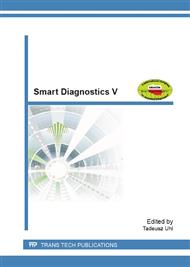[1]
P.D. Samuel, D.J. Pines, A review of vibration-based techniques for helicopter transmission diagnostics, Journal of Sound and Vibration, 282/1–2 (2005) 475-508.
DOI: 10.1016/j.jsv.2004.02.058
Google Scholar
[2]
F. Combet, L. Gelman, Optimal filtering of gear signals for early damage detection based on the spectral kurtosis, Mechanical Systems and Signal Processing 23/3 (2009) 652-668.
DOI: 10.1016/j.ymssp.2008.08.002
Google Scholar
[3]
J. Urbanek, J. Antoni, T. Barszcz, Detection of signal component modulations using modulation intensity distribution, Mechanical Systems and Signal Processing 28 (2012) 399-413.
DOI: 10.1016/j.ymssp.2011.12.018
Google Scholar
[4]
T. Barszcz, A. Jablonski, A Novel Method of Optimal Band Selection for Vibration Signal Demodulation, Mechanical Systems and Signal Processing 25/1 (2011) 431-451.
DOI: 10.1016/j.ymssp.2010.05.018
Google Scholar
[5]
T. Barszcz, Decomposition Of Vibration Signals Into Deterministic And Nondeterministic Components And Its Capabilities Of Fault Detection And Identification, Int. J. Appl. Math. Comput. Sci., 19/2 (2009) 327-335.
DOI: 10.2478/v10006-009-0028-0
Google Scholar
[6]
R. Zimroz, W. Bartelmus, Application of adaptive filtering for weak impulsive signal recovery for bearings local damage detection in complex mining mechanical systems working under condition of varying load, Diffusion and Defect Data Pt.B: Solid State Phenomena 180 (2012) 250-257.
DOI: 10.4028/www.scientific.net/SSP.180.250
Google Scholar
[7]
J. Antoni, Cyclostationarity by examples, Mech. Syst. and Signal Proc. 23/4 (2009) 987-1036.
Google Scholar
[8]
R. Zimroz, W. Bartelmus, Gearbox condition estimation using cyclo-stationary properties of vibration signal, Key Engineering Materials 413-414 (2009) 471-478.
DOI: 10.4028/www.scientific.net/kem.413-414.471
Google Scholar
[9]
J. Lin, M. Zuo, Gearbox fault diagnosis using adaptive wavelet filter, Mechanical Systems and Signal Processing 17/6 (2003) 1259-1269.
DOI: 10.1006/mssp.2002.1507
Google Scholar
[10]
P. Flandrin, G. Rilling, P. Gonçalvès, Empirical Mode Decomposition as a Filter Bank, IEEE Signal Processing Letters 11/2 (2004) 112–114.
DOI: 10.1109/lsp.2003.821662
Google Scholar
[11]
B. Liu, S. Riemenschneider, Y. Xu, Gearbox fault diagnosis using empirical mode decomposition and Hilbert spectrum, Mech. Systems and Signal Proc. 20/ 3 (2006) 718–734.
DOI: 10.1016/j.ymssp.2005.02.003
Google Scholar
[12]
J. Dybała, R. Zimroz, Application of Empirical Mode Decomposition for impulsive signal extraction to detect bearing damage – industrial case study, in: Fakhfakh T. et al . (Eds.) Condition Monitoring of Machinery in Non-Stationary Operations, Part 3, Springer, (2012), p.257–266.
DOI: 10.1007/978-3-642-28768-8_27
Google Scholar
[13]
R.A. Makowski, R. Zimroz, Adaptive bearings vibration modeling for diagnosis, Lecture Notes in Computer Science (including subseries Lecture Notes in Artificial Intelligence and Lecture Notes in Bioinformatics) 6943 LNAI (2011) 248-259.
DOI: 10.1007/978-3-642-23857-4_26
Google Scholar
[14]
R. Makowski, R. Zimroz, A procedure for weighted summation of the derivatives of reflection coefficients in adaptive Schur filter with application to fault detection in rolling element bearings Mechanical Systems and Signal Processing (2012).
DOI: 10.1016/j.ymssp.2012.05.005
Google Scholar
[15]
R. Makowski, R. Zimroz, Application of Schur Filtering for Local Damage Detection in Gearboxes, in: T. Fakhfakh, et al . (Eds.) Condition Monitoring of Machinery in Non-Stationary Operations Part 3, Springer, pp.301-308.
DOI: 10.1007/978-3-642-28768-8_32
Google Scholar
[16]
J. Urbanek, T. Barszcz, R. Zimroz, J. Antoni, Application of averaged instantaneous power spectrum for diagnostics of machinery operating under non-stationary operational conditions Measurement: Journal of the Internat. Measurement Confederation 45(7) (2012) 1782-1791.
DOI: 10.1016/j.measurement.2012.04.006
Google Scholar
[17]
M.T. Khabou, N. Bouchaala, F. Chaari, T. Fakhfakh, M. Haddar, Study of a spur gear dynamic behavior in transient regime, Mech. Systems and Signal Proc. 25/8 (2011) 3089-3101
DOI: 10.1016/j.ymssp.2011.04.018
Google Scholar
[18]
L. Gelman et al, Adaptive vibration condition monitoring technology for local tooth damage in gearboxes, Insight: Non-Destructive Testing and Condition Monitoring 47(8) (2005) 461-464.
DOI: 10.1784/insi.2005.47.8.461
Google Scholar
[19]
A.O. Boudraa, J.C. Cexus, EMD-based signal filtering. IEEE Transactions on Instrumentation and Measurement, 56/6 (2007) 2196–2202.
DOI: 10.1109/tim.2007.907967
Google Scholar
[20]
D. Yu, J. Cheng, Y. Yang, Application of EMD method and Hilbert spectrum to the fault diagnosis of roller bearings, Mechanical Systems and Signal Processing 19/2 (2005) 259–270.
DOI: 10.1016/s0888-3270(03)00099-2
Google Scholar
[21]
N.E. Huang, Z. Shen, S.R. Long, M.L.C. Wu, H.H. Shih, Q.N. Zheng, N.C. Yen, C.C. Tung, H.H. Liu, The empirical mode decomposition and the Hilbert spectrum for nonlinear and non–stationary time series analysis, Proc. of the Royal Society of London, Series A – Mathematical Physical and Engineering Sciences, vol. 454, (1998), p.903–995.
DOI: 10.1098/rspa.1998.0193
Google Scholar
[22]
G. Rilling, P. Flandrin, P. Gonçalvès, On Empirical Mode Decomposition and its algorithms, Proceedings of the 6th IEEE-EURASIP Workshop on Nonlinear Signal and Image Processing (NSIP-03), Grado, Italy, June 8-11, (2003), áAvailable at: http://perso.ens-lyon.fr/patrick.flandrin/NSIP03.pdfñ, (July 2012).
DOI: 10.1109/icassp.2005.1416052
Google Scholar


